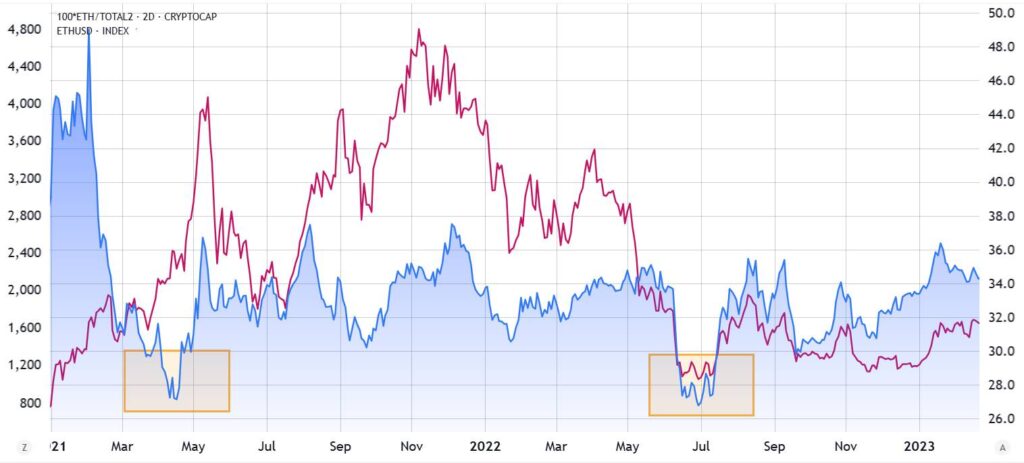The world of cryptocurrency has been buzzing recently, particularly surrounding Ether (ETH), which has seen its price rise above $1,700 after a prolonged period of selling that lasted 16 days. This surge comes amid substantial macroeconomic uncertainty and a notable drop in on-chain activity. Despite this rebound, it’s crucial to recognize that Ether has underperformed other altcoins by 23% this year, sparking mixed sentiments among traders.
The price movement has led some to speculate that ETH could be on the verge of a “generational” bull run, poised to foster a truly decentralized and permissionless financial ecosystem. But is this enthusiasm warranted?
In stark contrast to competitors like Solana (SOL), Tron (TRX), and BNB, which reached new all-time highs in 2025, Ether’s performance has raised eyebrows. Critics argue that Ethereum’s transition away from proof-of-work mining has diminished its former competitive edge. An intriguing aspect to consider is the drop in Ethereum’s transaction fees, which has plummeted by 95% since January. This decline points to potential price weaknesses for ETH moving forward.
Despite Ethereum holding the top position in Total Value Locked (TVL), the market has shown a rather tepid response to this metric, as it hasn’t translated into increased demand or scarcity for Ether. Currently, while some hope remains that Ethereum’s fundamentals might eventually improve, there is a noticeable decline in optimism among ETH holders. This shift stands in stark contrast to the robust enthusiasm seen in the Solana and XRP communities, particularly with the anticipation surrounding U.S. approvals for spot exchange-traded funds (ETFs).
Interestingly, during a recent period from April 21 to April 23, U.S.-listed spot Ether ETFs experienced $10 million in net outflows, whereas Bitcoin instruments were reaping record inflows.
Examining historical trends, Ether’s past price rallies and their subsequent fade-outs have instilled a sense of caution among investors. For example, back in June 2022, Ether’s market share dipped to around 26.5% as prices fell below $1,100. A brief recovery subsequently saw ETH rise to $2,000 by August, only to plummet again shortly after. Such trends have often led traders to opt for quicker profit-taking, reducing the likelihood of sustained price growth and new all-time highs.
The narrative surrounding Ether has evolved over time—from utility tokens to broader themes involving NFTs, artificial intelligence, and more recently, real-world asset tokenization. While some influencers are advocating for a strong momentum for ETH, others are more skeptical, warning of possible declines compared to Bitcoin’s performance. The path forward for Ether remains uncertain, and while hopes for recovery persist, historical data casts a shadow over the likelihood of a sustained rally in the current market climate.
Ether (ETH) Price Trends and Market Insights
The recent fluctuations in Ether’s price and its implications for investors can be summarized in the following key points:
- ETH Price Recovery
- Ether has recently climbed above $1,700 after a prolonged period of selling pressure lasting 16 days.
- This rebound comes amidst macroeconomic uncertainty and declining on-chain activity.
- Performance versus Competitors
- ETH has underperformed compared to the broader altcoin market by 23% year-to-date.
- Major competitors such as Solana (SOL) and BNB have seen significant gains, reaching new all-time highs, while Ether has not.
- Market Sentiment and Predictions
- Some traders believe that Ether may be on the verge of a “generational” bull run.
- However, there are concerns regarding lack of strong fundamentals to support a sustainable price increase.
- Ethereum Fee Trends
- There has been a 95% drop in Ethereum fees since January, indicating low demand for data processing on its network.
- This drop has raised concerns about ETH becoming inflationary due to new coins issued for staking rewards.
- Declining Investor Optimism
- Despite being the leader in Total Value Locked (TVL), there is declining enthusiasm among ETH holders.
- Competing cryptocurrencies and their potential ETF approvals are creating a challenge for ETH’s market position.
- Historical Price Patterns
- Past trends indicate that ETH price rallies have often been short-lived.
- Investors have learned to take profits quickly, reducing the likelihood of achieving new all-time highs.
- Investor Caution
- Historical evidence suggests that there may be further price corrections for ETH, making investors wary.
- This caution is tied to the narrative shifts in the cryptocurrency market, affecting investment strategies.
This analysis provides insights into the current state of the Ethereum market, emphasizing the importance for investors to remain vigilant and make informed decisions based on the evolving landscape.
Ether’s Market Performance: An In-Depth Comparison
Ether (ETH) has recently seen a rise above $1,700, breaking a streak of 16 days of selling pressures stemming from economic uncertainties and dwindling on-chain activity. However, this rebound does not tell the full story, especially when compared to the current landscape in the cryptocurrency market.
Some analysts express optimism over ETH potentially entering a “generational” bull run, advocating for its decentralized and permissionless nature. However, unlike other cryptocurrencies—such as Solana (SOL) and BNB (BNB)—that have achieved significant price milestones this year, Ether lagged behind, underperforming by about 23% year-to-date. The transformation from proof-of-work to proof-of-stake caused critics to argue that Ethereum has forfeited a competitive edge it once enjoyed. As a result, some traders are left questioning whether Ether can truly reclaim its former glory amidst a crowded altcoin market.
While ETH remains a dominant player with the largest Total Value Locked (TVL), its decline in transactional fee volume—a staggering 95% drop since January—signals potential weaknesses. This enormous reduction in fees raises questions about Ethereum’s inflationary pressures, as the deflationary mechanisms in place are not enough to stabilize the coin’s issuance needed for staking rewards. Investors might find themselves disillusioned, especially considering that even with ETH displaying strong fundamentals, enthusiasm among holders appears to be waning.
Comparatively, competitors like Solana and XRP are buzzing with excitement over potential approvals for their spot ETFs, which could bolster institutional demand for these assets. Meanwhile, Ether’s recent net outflow of $10 million in U.S.-listed spot ETFs starkly contrasts with Bitcoin’s record inflow. This shift underscores how institutional interest might soon pivot away from Ethereum if it doesn’t regain its footing.
Historical patterns also suggest that price rallies for ETH often fizzle out, leaving investors in a state of uncertainty. In the past, Ether’s market share dipped below critical thresholds, only to see fleeting recoveries that seldom resulted in lasting gains. Traders who bought high during previous surges often found themselves enduring long waits to break even. This cyclical behavior could deter newer investors who are looking for stable returns and might lead them to favor other emerging cryptocurrencies showing more robust, sustained momentum.
Potential beneficiaries in this scenario include traders heavily invested in Solana or XRP, who are buoyed by the prospect of ETF approvals, as well as those focusing on newer financial instruments that leverage Ethereum’s network capabilities without the historical baggage. Conversely, ETH holders could face significant hurdles if these trends continue, especially amid an environment where competitive altcoins start to capture market share and imagination.
In essence, while the recent uptick in Ether’s price may provide some glimmer of hope, the broader context presents a complicated narrative. Stakeholders must navigate these waters cautiously, as shifting dynamics within the cryptocurrency landscape may determine whether ETH can rebound or if newer players will take the stage.

















